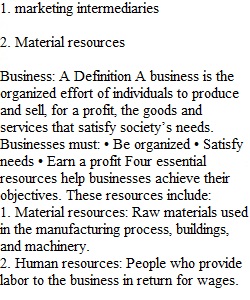


Q Business: A Definition A business is the organized effort of individuals to produce and sell, for a profit, the goods and services that satisfy society’s needs. Businesses must: • Be organized • Satisfy needs • Earn a profit Four essential resources help businesses achieve their objectives. These resources include: 1. Material resources: Raw materials used in the manufacturing process, buildings, and machinery. 2. Human resources: People who provide labor to the business in return for wages. 3. Financial resources: Money used to pay salaries, purchase materials, and operate the business. 4. Informational resources: Information on how effectively the other three resources are being combined and used. Businesses are usually classified as one of three types. Service businesses produce services rather than goods. Dry cleaners, dentist offices, and tutoring centers are examples. Manufacturing businesses process material resources into tangible goods such as shoes, cereal, or appliances. Marketing intermediaries buy products from manufacturers and resell them. Marketing intermediaries may include retailers or wholesalers. Business does not always happen in a brick-and-mortar location. Some retailers offer items for sale only on the internet and many retailers have both a physical and online presence. e-Business is the organized effort of individuals to produce and sell for a profit, the goods and services that satisfy society’s needs through the facilities available on the internet. Online shopping has been growing steadily for years but received a COVID-19-related boost in 2020 with 44 percent year-over-year growth. Satisfying Needs Companies produce goods and services that satisfy the needs of its customers. Many firms realize that customers have different needs and offer many different products to satisfy those differences. Over time, customer needs may change, so businesses must adapt to meet those changes. Market research and talking to customers can help businesses determine customer needs. Business Profit As you learned earlier, a business produces goods and services to earn a profit. When a business sells a product or service, it receives money (sales revenue) from the consumer. After the business pays for expenses involved in running the business, anything left over is profit. Sometimes, a business may incur a loss, when its expenses are more than its sales revenue. Operating at a loss is not sustainable year after year, so managers must find a way to increase revenues and reduce expenses. If they cannot, they may be forced to file for bankruptcy or close the business. Many people in business think that earning a profit is the most important goal for a business. However, some stakeholders believe that businesses should also focus on social responsibility and the environment. Stakeholders are all the different people or groups of people who are affected by an organization’s policies, decisions, and activities. Profits become the property of the owners of a business. There are certainly risks for owning and operating a business, and the profit serves as both payment and reward to business owners. Risks of owning a business include the possibility that the owner may not get paid because employees, suppliers, and lenders must be paid before an owner is. Additionally, business owners are at risk of losing what they have invested in the business if it fails. 1.Businesses that buy products from manufacturers and resell them would be classified as ________. 2.Which type of essential resource for businesses would buildings and machinery be considered? 3.When expenses total more than sales revenue, a business ________.
View Related Questions